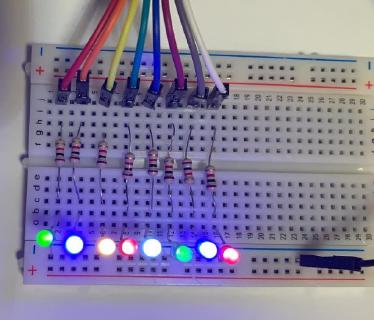Adventures in hardware, part 4 - LED expander
Why more LEDs?
During the process of developing a 4x4 keypad reader I realized I need more LEDs for diagnostic information. As my Elbert v2 has plenty of digital input/output pins, it should only be a matter of wiring the LEDs to the IOs.
External LEDs should be connected serially through a resistor - otherwise, if connected directly, they will draw as much current as they can and will burn (hopefully sacrificing themselves to save the development board 🙂).
Determining the resistor value
I admit upfront that I picked a 1 kΩ resistor out of laziness(and I couldn’t find any 330 Ω ones in my resistor bag).
To do it properly, one should calculate the resistor value as
Resistor value [Ω] = (Supply voltage [V] - LED forward voltage [V]) / desired LED current [A]
Forward voltage of the LEDs (measured across the illuminated ED with a voltmeter):
| Color | Vf |
|---|---|
| Red | 1.71 |
| Blue | 2.57 |
| Green | 1.88 |
| Orange | 1.88 |
| White | 2.60 |
The pin voltage is 3.3V, the forward voltage of my LEDs ranges from 1.71 to 2.6 V, so according to Ohm’s law:
# red LED (dimmest) at 1.59 mA
R = V/I = (3.3V - 1.71V) / ??? A = 1000Ω
1.59V / 1.59 mA = 1000 Ω
# white LED (brightest) at 2.6 mA
2.6V / 2.6 mA = 1000 Ω
Connecting to the Elbert V2 board
I used the P2 Pmod header
as my P1 header is already occupied by the keypad. That meant declaring the pins 3-8,10,11 (according to the datasheet) in my .ucf file as.
NET "led_ext[0]" LOC = P10 | IOSTANDARD = LVCMOS33 | SLEW = SLOW | DRIVE = 12;
Lighting the LEDs
A short VHDL module builds up the logic to illuminate the LEDs on a button press.
entity top_module is
Port ( Clk : in STD_LOGIC;
led_ext : out STD_LOGIC_VECTOR(7 downto 0);
button0 : in STD_LOGIC);
end top_module;
architecture Behavioral of top_module is
begin
process(clk) begin
if rising_edge(clk) then
for i in 0 to 7 loop
led_ext(i) <= not button0;
end loop;
end if;
end process;
end Behavioral;
The result
Now I have eight more LEDs for debugging, with some space to add eight more on this breadboard if necessary!
